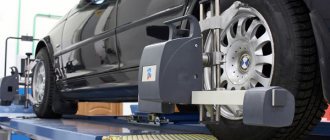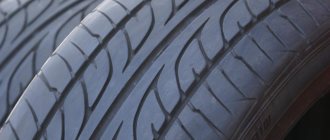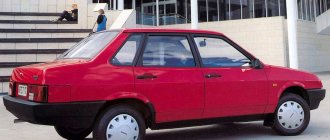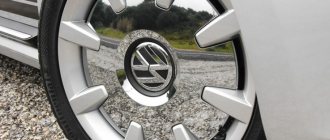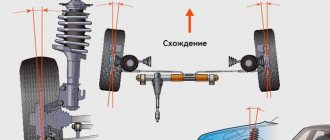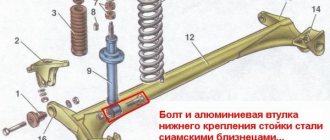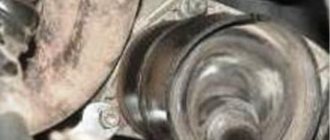The opinions of motorists on the issue of changing wheels on a car differ in some places. The first group claims that the procedure is useless and harms the tires. The second category constantly uses the procedure in the belief that this allows for maximum uniform tire wear. Both statements are true in their own way, but in individual cases. Tires on passenger cars need to be changed constantly. The requirement is due to the uneven load on different wheels and, as a result, different wear. The requirement is especially relevant for trucks. Here, when changing the shoes of the car and trailer, it is necessary to change the tires. The load of a tractor and a truck is very different.
The procedure is limited to vehicles equipped with a pressure control system. The control unit determines what side it is on, and if there is a puncture, it shows the driver the location of the puncture. If you mix up the disks, errors in the on-board system may occur.
Tire transfer is done according to a certain pattern. If you install your wheels incorrectly, the desired effect will not be achieved.
When is a tire rotation recommended?
Service station employees recommend paying attention to the condition of the wheels, and if impressive numbers already appear on the dashboard indicating the mileage, and it is somewhere around 5,000-10,000 kilometers, then the rearrangement of the wheels is shown, the diagram is selected as desired. You should be extremely careful if you bought a used car second-hand, because then dashing craftsmen could twist the mileage figures, hiding the true wear and tear of the mechanical “stuff” of the car that was previously put up for sale. Then you should be guided by the condition of the tread pattern. We noticed wear on the front or rear wheels, assessed them as a percentage, and decided to rotate the tires according to the scheme. The following reasons for rearranging wheels are determined:
- Uneven tire wear.
- The need to strengthen one or another pair of wheels for front-wheel drive and rear-wheel drive vehicles, respectively.
- The desire to extend the life of tires, improve their condition by temporarily changing the load level.
- Unforeseen traffic situation, emergency repair work in the field.
Thus, there are no strict recommendations on when it is worth rotating the wheels; their condition is simply assessed, time is found for the replacement procedure, and money is allocated to pay for the work, if you do not do everything on your own.
Timing of reshuffle
The main guideline when carrying out various preventive operations is the vehicle's operating manual. It tells you when to rotate your tires. The more often this operation is performed, the more evenly the tires wear out.
But common sense dictates that there is no point in performing such prevention weekly. Most manufacturers recommend changing wheels after 10-20 thousand kilometers. The lower limit of this interval is relevant for those who constantly travel on bad roads or adhere to an aggressive, sporty driving style.
Other factors also increase wear: the condition of the suspension and steering, low tire pressure, and regular overload of the vehicle. The upper limit is acceptable for lovers of careful driving and owners of high-quality branded tires. It resists abrasion longer and is less likely to get damaged. It is very convenient to rearrange tires during the seasonal change of tires. When removing a summer or winter set, before sending it for storage, make notes by which you can determine which axle and which side the wheels were on - PP, PL, ZP, ZL.
Is it necessary to change wheels?
Some may think that changing tires is an unnecessary operation. However, experienced car service employees advise not to neglect this preventive measure, because not only the wear of tires, but also safety on the road depends on it.
The fact is that the tread on the rear and front wheels does not wear out equally. When cornering, braking and difficult maneuvers the same areas are involved, and as a result the tire loses its shape. If you don't want to throw away the rubber due to scuffs in certain areas, you should take the opportunity to extend the life of the wheels.
Permutation schemes
Although manufacturers do not produce separate right or left tires, it is important to follow certain patterns when rotating. If you decide to rotate the tires yourself, mark them before you begin to avoid confusion.
There are several common ways to rearrange tires. The choice depends on the drive axle and tire type. For front-wheel drive cars, two options are used. In the first case, the rear wheels are moved to the front axle (left - to the left, right - to the right), and the front wheels - to the rear. In this case, the left and right tires change places. The second scheme is a little simpler: the left rear wheel becomes the right front, the right rear becomes the left front, and vice versa.
So tires are replaced diagonally. If your car has all-wheel drive or rear-wheel drive, the second of the schemes described above can be used. Another option is to install the front wheels without changing the rear side. The right rear will become the left front, the left rear will become the right front. Rubber that has a directional tread pattern is changed only along the axes, without changing the side. And if you have a mixed-width set, you can only change the side: we swap the left and right tires on each axle.
When you notice that the tires are too worn and rotating the tires will not help, choose a suitable replacement for them on the website https://megawheel.ru/. The catalog contains tires from the best European, Asian and American manufacturers, and a wide selection of standard sizes will allow you to choose a set for any passenger car or truck.
Rotation is useful for a number of reasons. If produced in accordance with the manufacturer's recommendations, tires provide better handling and more effective traction and wear more evenly. Other driving characteristics may be improved.
So when should you change your wheels? For performance tires, we recommend doing this every 5,000 to 8,000 kilometers, even if the tires show no signs of wear. It is convenient to perform the rotation simultaneously with an oil change, when the car is, one way or another, placed on a lift. If the wheels move evenly in a rotation pattern, all tires will wear equally.
Remember that rotation cannot affect wear caused by mechanical problems or incorrect tire pressure. It is also necessary to study the instructions to follow the scheme recommended by the manufacturer. The tires on the front axle work completely differently than on the rear. A front-wheel drive vehicle loads the tires differently than a rear-wheel drive vehicle. A sports car wears out its tires more than a family sedan. The location of each wheel determines its degree and type of wear.
Four wheel rotation
Tires are bound to wear out over time, but it will be much better if this process occurs evenly. As the tread depth decreases, the tires become more responsive to driver inputs and perform better on dry surfaces. However, consistent responses can only be expected if all tires wear equally.
When the tires have served their intended life, it is better to immediately change the entire set, then the replacement will not have a negative impact on the handling of the car.
In addition, new tire models are constantly appearing on the market, improving the performance of their predecessors. Replacing an entire set allows you to keep up with modern tire technology, rather than being content with yesterday.
On front-wheel drive vehicles, the adjustment can be made in a cross pattern towards the rear axle (Fig. A) or in a cross pattern (Fig. B)
On vehicles with rear-wheel drive or all-wheel drive, the adjustment is carried out crosswise in the direction of the front axle (Fig. C) or also in a cross pattern (Fig. B)
For tires with a directional tread pattern, use the diagram in (Fig. D)
For non-directional tires, if the front and rear axles have different tire sizes, use the pattern shown in (Figure E)
Many cars are equipped with a tire that cannot be included in the wheel rotation scheme, but if the car's spare tire has the same size, type and load capacity as the four main wheels, it should also (unless otherwise indicated) be included in the rotation scheme .
Follow the vehicle manufacturer's recommended rotation procedure, if available, or use one of the following diagrams and replace the right rear tire with each rotation. The wheel that replaces the right rear one is stored in the trunk until the next change.
Thanks to the five-wheel rotation pattern, you can always be sure that the spare tire is in good condition and the wheel itself is inflated and ready for use. A car's mileage on a set of five wheels increases by 20%. In this case, all five tires wear out evenly. And when it comes time to replace them, the driver has the opportunity to choose a new set from the latest tire developments.
In addition, the use of this scheme ensures the same tread depth on all five wheels. This is especially important for four-wheel drive vehicles. If you replace a punctured wheel with a spare one with unused tread, a difference in diameters will arise, which can lead to improper operation of transmission elements.
For safe driving and reliable vehicle control, you cannot do without installing new tires on your car. However, rubber does not last forever and its wear cannot be uniform, for various reasons, on all wheels. Of course, no one is tempted to change all four tires at the same time in order to improve the reliability of road grip and steering feedback.
So let's pull a rabbit out of the hat. Rotating the tires on your car will help you save money. The rotation process is usually carried out during the change of seasonal tires at a service station. But tire wear does not depend on the season, but occurs as a result of everyday use of the car. And the driver needs to know when the tires need to be rotated, and how to do it himself.
What you need to rotate your tires
There are tools in the trunk of any car, many of which are useful for repair work. The idea is to rearrange the wheels on a car, the diagram is supposed to be available, then the following available tools will be needed:
- Jack. A model of a powerful floor hydraulic jack is suitable, with the help of which it will be possible to lift the car and fix it, perhaps for several hours, while the wheels rotate from one axle to another.
Jack - Stand. To enhance the power of the jack and securely fix the machine in weight, it is recommended to use a stand to the jack. It can be factory equipped or can be replaced with any other durable structure, for example, a cinder block or a log block.
Jack stand - Rearrangement scheme. Determine for yourself the best option so that rearranging tires according to the scheme is crowned with success and proves in practice its profitability and correctness.
When undertaking such a painstaking procedure on your own, try to enlist the support of friends or family. There is no doubt that you will need support and help. When repairing a car, there is always something to support, serve, smoke, take out, move, substitute, and so on. The list of actions can be endless!
Which tires are better
Based on the cord design, radial tires are preferable. Such tires are more reliable, they can withstand heavy loads when driving, and are more stable when deformed. Radial tires take longer to wear than bias-ply tires. Therefore, bias-ply tires are practically not produced at present. Almost all car owners have two sets of tires. For operating a car in winter, these are winter tires, for the summer, summer tires.
All-season tires can be used in both summer and winter. may be studded. Such tires are allowed only in a few countries where snow often and heavily falls in winter and ice forms on the road surface. Russia is also on this list. All-season, summer and winter tires have their own design characteristics that improve vehicle handling.
Front-wheel drive or rear-wheel drive vehicles can be equipped with tires with different patterns. Such tires are installed in pairs on one axle, for example, in front of the tire with one pattern, in the rear - with another. It is prohibited to install bias tires on one axle and radial tires on the other. The dimensions must be the same. All-wheel drive vehicles must have the same tires.
Tires with different treads and different sizes are strictly prohibited. This is due to the design of the transmission. If you drive a car with different tires, the car's transmission will quickly fail. In addition, driving on different tires becomes dangerous; a car will behave unpredictably on a slippery road.
Wheel rotation frequency
The more often you rotate the wheels, the more evenly the tires will wear.
.
But, since doing this too often is quite troublesome, experts advise changing the wheels during the periodic one - when the car is somehow lifted onto a lift. As a rule, a mileage of 8-10 thousand km
is quite enough for the next rotation of wheels: in this simple way you can not only
extend the life of the tires
, but also maintain the safety of movement at the proper level.
We'll tell you and teach you
When changing the location of the wheels on your car yourself, you must remember that the pattern of their rearrangement depends on the tire tread pattern.
Why do you need to rotate wheels?
For every car, regardless of whether it is front-wheel drive, rear-wheel drive or all-wheel drive, the tires of the wheels located on the drive axle wear out more intensively than on the free one.
Extending the life of car tires by ensuring even wear on their treads is possible only by periodically rotating the car's wheels.
For most cars, this procedure is recommended to be performed every 10 thousand kilometers.
Ways to rotate wheels
For tires with a directional tread pattern, changing wheels is done by swapping the right front wheel with the right rear one, and the left front wheel with the left rear one.
As for all other wheels, some sources outline their rotation schemes separately for front-wheel drive, rear-wheel drive and all-wheel drive vehicle types.
Rotating wheels using a spare wheel
This type of rotation allows you to extend the life of the wheels by approximately 20%.
, but in reality this method is almost never used: many modern cars either don’t have a spare tire in the trunk at all, or use a small-size spare tire as one. And even if your car is equipped with a full-size spare tire, in practice it most often differs either in the tire model or the type of wheel. However, if the spare wheel is completely identical to the wheels installed on the car, then rotation in this case can be extremely useful. For ease of wheel replacement, the tread pattern type should be either asymmetrical non-directional or symmetrical non-directional. The rotation process in this case is no longer as obvious as in previous methods.
Method 1
The front right wheel is removed in place of the spare wheel, the spare wheel is installed in the place of the rear right wheel, the rear right wheel is installed in the place of the front left wheel, the front left wheel is installed in the place of the rear left wheel, the rear left wheel is installed in the place of the front right wheel.
Method 2
The spare wheel is installed in the place of the rear right wheel, the rear right wheel is installed in the place of the front right wheel, the front right wheel is installed in the place of the rear left wheel, the rear left wheel is installed in the place of the front left wheel, and the front left wheel, in turn, is removed in place of the spare wheel.
Symmetrical directional tread pattern
Such tires are becoming less and less common in summer tire lines and are almost always winter tires: the V-shaped tread makes it possible to remove water from the contact patch as efficiently as possible. Thus, in the MICHELIN model range, CrossClimate summer tires and a number of winter tires (Latitude X-Ice 3, Alpin 5, etc.) have a directional tread pattern. Rotation with directional tires installed on the rims can be done in only one way: by swapping the front and rear wheels, i.e., the front left wheel in place of the rear left one, the front right wheel in place of the rear right one.
Asymmetrical non-directional tread pattern
The most popular type of tread on civilian tires at the moment is asymmetrical.
.
This, for example, is the case with most models of the MICHELIN summer line, ranging from economical to sporty. When installing asymmetrical tires on rims, it is necessary to align the front side of the tire with the front side of the rim
: for this purpose, the outside and inside inscriptions are present on the sidewalls (the outer and inner side of the tire) and there is no rotation direction arrow.
The convenience of this type of tread is that the wheel assembly can be changed between each other in any way: the outer side of the tire will remain external in any case
. In this case, it is appropriate to use any of the rotation methods. Usually the most suitable method for rearranging wheels is indicated in the car's operating instructions, but if you don't have one on hand, you can choose one of the methods we suggest.
Method 1
The front left wheel changes with the rear right one, and the front right wheel changes with the rear left one. This type of replacement is suitable for any type of vehicle drive and is most preferable for all-wheel drive vehicles.
Method 2
The rear wheels are moved to the front axle (the right rear wheel is placed in place of the right front one, the left rear wheel is placed in place of the left front one), while the front wheels are installed in place of the rear ones diagonally (the right front wheel is placed in place of the left rear one, the left front wheel is placed in place of the front axle). right rear seat). This method is suitable for cars with rear-wheel drive and all-wheel drive.
Method 3
The front wheels are installed in place of the rear ones (the right front wheel is in place of the right rear wheel, the left front wheel is in place of the left rear wheel), and the rear wheels, in turn, are moved diagonally to the front axle (the right rear wheel is placed in place of the left front wheel, the left rear - in place of the right front). This method is intended for cars with front-wheel drive.

